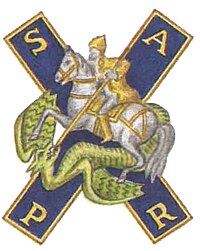|
Moscow Life Guards Regiment
Moskovsky Guards Regiment (Russian: Московский лейб-гвардии полк) was a Russian Imperial Guard infantry regiment. Established in October 1817 it continued in existence until the Russian Revolution of 1917. HistoryFoundationThe Moscow Guards Regiment was created on 12 October 1817. In order to constitute the new unit, the two senior battalions of the existing Litovski Regiment of line infantry were transferred to a senior corps of the Imperial Guard designated as the "Old Guard" (ru: старая гвардия). The Litovski itself had been raised on 7 November 1811 and this now became the nominal date of foundation for the Moscow Guards.[1] Campaigns
Decembrist revoltOn 25 December 1825 the Moscow Regiment played a leading role in the Decembrist revolt. Led by reform minded young officers the regiment paraded for most of a day in the Senate Square of Saint Petersburg, in protest against the accession of Tsar Nicholas I. At dusk they were fired on by loyalist artillery and routed.[2] The officers involved were executed or exiled, and the ordinary soldiers transferred to line infantry units.[3] However the Moscow Regiment, survived with its numbers restored by mass transferrals from the L.G. Grenadierski Regiment.[4] Uniforms and physical appearanceThroughout its history under the Russian Empire, the regiment wore the standard uniform of the Infantry of the Imperial Guard, which from 1683 to 1914 was predominantly of a dark green (eventually verging on black) colour. The main distinctions of the Moscow Guards Regiment were the all-red facings (plastron, collar, cuffs and shoulder straps). On the collars were worn distinctive regimental patterns of braid (litzen) in gold or yellow material.[5] In 1912, in recognition of its service during the Russo-Turkish War, officers of the regiment were authorised to wear a large metal gorget of a design dating from 1808.[6] A peculiarity of the Russian Imperial Guard was that recruits for most regiments were required to meet certain criteria of physical appearance, in order to provide a standardised appearance on parade.[7] For the Moscow Regiment conscripts were selected on the basis of their hair colour (red or reddish-brown).[8] References
Sources
|
||||||||||||||||||||||
